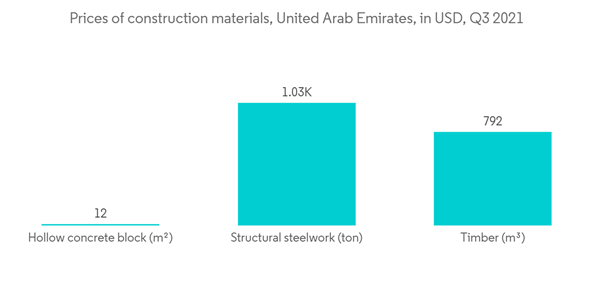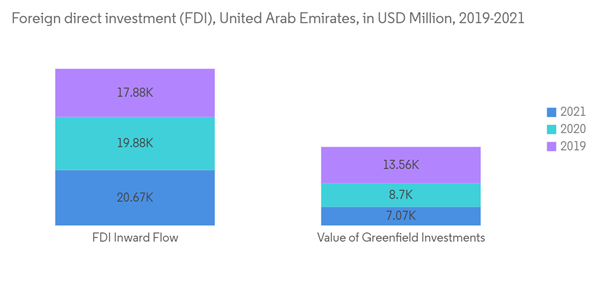Key Highlights
- The market is driven by the demand for fusion architecture that has a mix of both western and middle-eastern cultures. Furthermore, the market is driven by the advanced technology being used for the design and construction of these facades.
- Future façades are more likely to be adaptable. While incorporating flexible façades is critical for improving designs, it is also critical to incorporate automated designs that transform themselves simultaneously in response to interior and exterior conditions.
- Flexible shades adapt to varying meteorological conditions, protecting from solar radiation and maximising natural light without glare, changing their characteristics throughout the day and year in response to the environmental conditions at the Barjeel Art Museum in Sharjah, UAE for ultimate occupant comfort and energy consumption. The combination of flexible designs and automation will result in a more climate-ready, more resilient architecture while maintaining the interface's aesthetic impact.
- There is a growing demand for the use of fibre laser applications to improve water resistance, improve welding bonds, and prevent grain formation. The rain-screen system is another popular cladding technology. Because the air cavity connected to the load-bearing wall repels direct rain and moisture, the rain-screen cladding system provides consistent ventilation. We can see more electrochromic and self-cleaning glasses spread across the façades of high-rise buildings. This electric glass can be switched between translucent and transparent appearances to provide more privacy or access to more natural light. Users of the building can adjust the transmitted ultraviolet and natural light without glare. As a result, smart systems are being used to increase energy consumption.
- The Museum of the Future is a seven-story hollow silver ellipse decorated with quotes from Dubai's ruler in Arabic calligraphy. The museum is a seven-story hollow silver ellipse decorated with quotes from Dubai's ruler in Arabic calligraphy. It stands proudly on Sheikh Zayed Road, Dubai's main thoroughfare. In the evening, a colourful laser light show illuminated the building's striking facade as crowds gathered outside to catch a glimpse. It was later officially opened by Dubai's ruler, Sheikh Mohammed bin Rashid Al-Maktoum, whose vision of the future is credited with inspiring the Museum of the Future.
- Even though Muslims constitute approximately 80% of the UAE's population, the three Abrahamic religions (Islam, Christianity, and Judaism) are given equal weight at Abu Dhabi's new interreligious campus. The mosque, synagogue, and church of the project coexist imaginatively, occupying three indistinguishably cubic forms on a "secular" tourist pavilion. Although each of the three main buildings is oriented differently on the site, Ghanaian-British architect David Adjaye's firm, Adjaye Associates, claimed in its designs that it considered the connections of the faiths. In addition to prayer rooms, the complex aims to promote intercultural communication. To that end, a fourth area - an educational centre - will be a gathering place for all people of kindness.
UAE Facade Market Trends
Increase in real estate construction throughout the country
The Covid pandemic, which has now lasted into Q1 2022, is causing a significant shift in buying behaviour in the UAE real estate market. The property market is now showing a preference for completed residential units over off-the-plan units. This is reflected in sales through Q1 2022, with 70% of total transactions focused on finished units, according to Dubai Land Department data. Because of low mortgage rates, more end-users are continuing to purchase throughout the city. Buyers prefer larger living spaces in low-density neighbourhoods. The average sales price increased by 11% in Q1 2022, owing primarily to premium villa sales. Apartment buildings that are ready to go with larger spaces and a strong community offering also performed well as a stock of ready villas depleted.Apartments are currently accounting for the majority of total completions in Q1 2022, as new villa supply is limited due to a lack of stock and pipeline. Villa stock in prime Dubai areas is limited, with only 3.6% of planned deliveries in prime submarkets in 2022, keeping prices high. Large developers launched over 10,000 new townhouses and villas in May 2022, but handover is not expected until between the end of 2024 and 2025. Only 30% of the villas being built are in luxury communities with golf courses, such as Dubai South, Dubai Hills, and Arabian Ranches 3, with the remaining 5% being built in prime market areas, which will help prices in those areas stay strong.
Increase in infrastructure investment driving the market
The United Arab Emirates (UAE) has made tremendous strides in sustainable development and economic growth, as well as in the development of clean energy and the efficient management of its resources. According to a UN Industrial Development Organization survey, the country now ranks first in the Middle East and North Africa (MENA) for having high-quality infrastructure that supports national Sustainable Development Goals (SDGs). The country ranked 11 on the global index, ahead of Portugal, Singapore, Finland, Denmark, and Belgium. UNIDO employs a set of 36 metrics to assess the quality of infrastructure for sustainable development in 137 countries.In the United Arab Emirates, AWS opens its second region. Amazon Web Services (AWS)'s second UAE region will support approximately 6,000 full-time jobs and will represent an investment of more than USD 5 billion (AED 20 billion). The AWS Middle East (UAE) Region has been announced as the company's newest Middle East region. AWS will invest approximately USD 5 billion in the UAE's local economy over the next 15 years as part of its ongoing expansion plan into the UAE. This amount will cover capital expenditures (particularly data centre construction), operational expenses, and purchases of goods and services from regional businesses. As a result, according to AWS estimates, this new UAE infrastructure will add USD 11 billion (AED 41 billion) to the UAE’s GDP, over the next 15 years.
When it comes to property investment, the UAE real estate market has become one of the most popular in the world. However, with real estate prices skyrocketing, it's understandable that some investors are concerned about where things will go in the coming years. The UAE real estate market is thriving but volatile. Despite rising prices, there are some reservations about long-term investment in this sector. By 2021, the UAE real estate market had experienced significant growth and had recovered from the pandemic's aftershocks. In 2021, approximately 61,000 properties were sold in the UAE, with prices rising. Almost every street has a new property development, with some even having a waiting list before they are built. Dubai continues to lead the way in economic development and property prices and attracts more international attention than any other city in the country.
UAE Facade Market Competitor Analysis
The UAE Facade Market is fairly fragmented with more regional and local players with a few global players. Domestic players occupy a major share of the market as they have a good hold on the local architecture and traditions which are always looked upon by investors. The major players are Inventure Metal Products Industries LLC, Synaxis Saveto LLC, A E Prime Engineering Consultants, Dar Al Handasah (Shair & Partners) Consultants, Egylum Engineering Services, and many more. The use of advanced technology and sustainability are some of the factors which can discriminate top players from others.Additional Benefits:
- The market estimate (ME) sheet in Excel format
- 3 months of analyst support
Table of Contents
Companies Mentioned (Partial List)
A selection of companies mentioned in this report includes, but is not limited to:
- Lindner Group
- Meinhardt group
- Bouygues SA
- Seele Middle East FZE
- Koltay Facades
- PERMASTEELISA S.P.A,
- Ramboll Group A/S
- Fibrex Construction Group
- Aygun Aluminyum A.S
- AFS International BV










